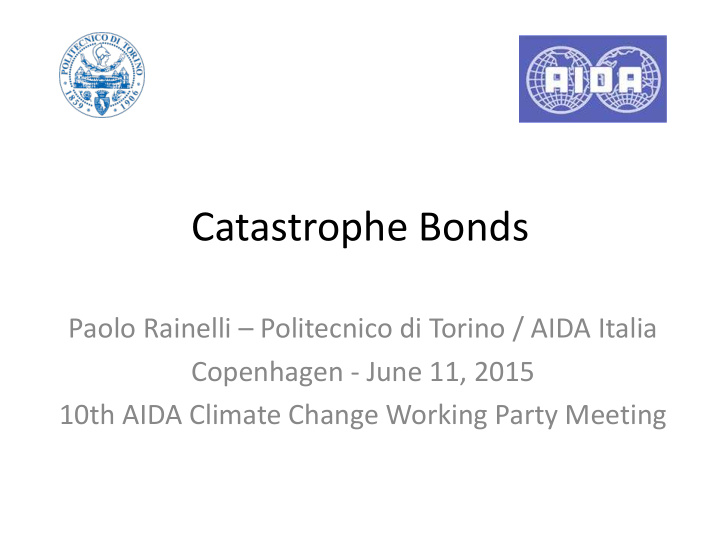



Catastrophe Bonds Paolo Rainelli – Politecnico di Torino / AIDA Italia Copenhagen - June 11, 2015 10th AIDA Climate Change Working Party Meeting
What They Are Catastrophe bonds (aka cat bonds ) are a form of insurance securitization to create risk-linked securities which transfer a specific set of risks (generally catastrophe and natural disaster risks) from an issuer or sponsor to investors
Cat Bond Structure
Legal Considerations • Reimbursement of the principal amount to investors is subject to a condition precedent ( i.e. , non-occurence of the trigger event) • The SPV is subject to an alternative payment obligation (towards Sponsor or Investors) • Coupon payment is certain and unconditioned
Origins (Mid 90’s) Northridge Earthquake 1994 Hurricane Andrew 1992
Some Figures • In 10 years (between 1997 and 2007) issuance volumes increased more than sevenfold from less than USD 1 billion to over USD 7 billion • Outstanding cat bonds’ market is now over USD 24 billion • In 2015 issuances have already reached USD 4.9 billion
Growth of the Cat Bond Market
Cat Bonds Cumulative Issuance
Trigger Events • Indemnity (actual losses experienced by the issuer) • Industry loss trigger (cumulative) • Parametric index trigger (index of weather or other disaster conditions)
Cat Bonds by Trigger Event
Indemnity • Per-occurrence cover • Aggregate cover (multiple events over the course of each annual risk-period) • Multiple loss approach (only triggered by second and subsequent events)
Cat Bonds Outstanding by Sponsor
Italian Market Lion I Re Limited Azzurro Re I Limited European windstorm Earthquakes (mainly Italy) EUR 190 million (April 2014) EUR 150 million (June 2015)
Cat Bonds’ Leading Banks, Brokers and Intermediaries
Investors’ Base • In 1999 primary insurers and reinsurers together purchased 55% of the cat bond issued volume. The remaining demand came from money managers (30%), hedge funds, banks and dedicated funds (5% each). • In 2010 dedicated funds (46%), money managers (23%), and hedge funds (14%) were by far the largest purchasers with insurers and reinsurers falling to a mere 8%. A radical change of the investors’ base
Investment drivers Pros Little or no correlation with traditional asset classes • (diversification) Attractive returns • Knowledge of the market to use cat bonds in the future • Better than the conventional reinsurance market • Liquidity (only for selected series) • Cons They do not fit with asset and liability management • Regulatory constraints • Missing know-how •
Types of Securitized Risks Currently Hurricanes, Earthquake, Typhoons, Windstorms, Thunderstorms, Floods, Hails but There is room to adapt the model to typical life risks such as longevity and health insurance claims
Trend of 2015 Issuances by Risk Type
Selected Issues and Areas of Research • Regulatory constraints, tax and choice of law • Unenforceability issues in purely speculative environments ( i.e. , gambling exceptio ) • Pricing models ( e.g. , market based and actuarial) • Catastrophes’ data and impact of climate change • Regulation…
«In the Beginning it is the Market, In the End it is the Law»
References • www.artemis.bm (a database with almost 300 cat bond deals, market data and updated reports) • LEWIS, In Nature’s Casino , New York Times (August 26, 2007) • BRAUN-MÜLLER-SCHMEISER, What drives insurers’ demand for cat bond investments? Evidence from a Pan-European survey (2012)
A lot of work ahead of us…
Thank you paolo.rainelli@polito.it
Recommend
More recommend